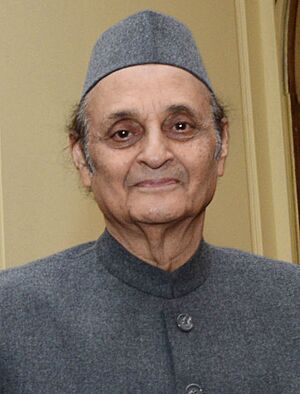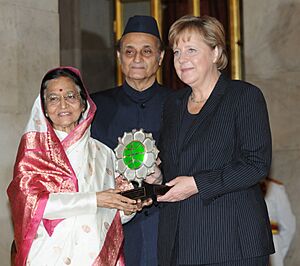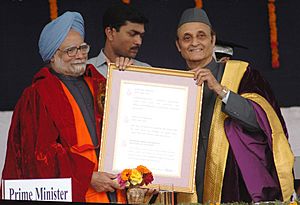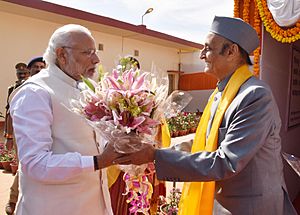Karan Singh facts for kids
Quick facts for kids
Karan Singh
|
|
|---|---|

Singh in 2013
|
|
| 1st Governor of Jammu and Kashmir | |
| In office 30 March 1965 – 15 May 1967 |
|
| Preceded by | Position established Himself as Sadr-i-Riyasat |
| Succeeded by | Bhagwan Sahay |
| Sadr-i-Riyasat of Jammu and Kashmir | |
| In office 17 November 1952 – 30 March 1965 |
|
| Prime Minister | Sheikh Abdullah Bakshi Ghulam Mohammad Khwaja Shamsuddin Ghulam Mohammed Sadiq |
| Preceded by | Position established |
| Succeeded by | Position abolished Himself as Governor |
| Prince Regent of Jammu and Kashmir | |
| In office 20 June 1949 – 17 November 1952 |
|
| Monarch | Sir Hari Singh |
| Ambassador of India to the United States of America | |
| In office 1989–1990 |
|
| Preceded by | P. K. Kaul |
| Succeeded by | Abid Hussain |
| Union Minister of Education and Culture | |
| In office 30 July 1979 – 14 January 1980 |
|
| Prime Minister | Charan Singh |
| Preceded by | Pratap Chandra Chunder |
| Succeeded by | B. Shankaranand |
| Union Minister for Health and Family Planning | |
| In office 9 November 1973 – 24 March 1977 |
|
| Prime Minister | Indira Gandhi |
| Preceded by | Uma Shankar Dikshit |
| Succeeded by | Raj Narain |
| Union Minister of Tourism and Civil Aviation | |
| In office 13 March 1967 – 9 November 1973 |
|
| Prime Minister | Indira Gandhi |
| Preceded by | Ministry established |
| Succeeded by | R. Bahadur |
| Member of Parliament, Rajya Sabha | |
| In office 28 January 2000 – 27 January 2018 |
|
| Succeeded by | Sanjay Singh |
| Constituency | National Capital Territory of Delhi |
| Member of Parliament, Lok Sabha | |
| In office 1971–1984 |
|
| Preceded by | G. S. Brigadier |
| Succeeded by | Girdhari Lal Dogra |
| Constituency | Udhampur |
| In office 1967–1968 |
|
| Preceded by | Constituency established |
| Succeeded by | G. S. Brigadier |
| Personal details | |
| Born | 9 March 1931 Cannes, France |
| Political party | Indian National Congress (1947–1979; 2000–present) |
| Other political affiliations |
Jammu & Kashmir National Conference (1996–1999) Independent (1984) Indian National Congress (U) (1979–1984) |
| Spouse | Yasho Rajya Lakshmi |
| Relations | Dogra dynasty Chitrangada Singh (daughter-in-law) Bhim Singh (kinsman) Dhian Singh (ancestral Kinsman) |
| Children | Vikramaditya Singh, Ajatshatru Singh, Jyotsna Singh |
| Parents | Maharaja Sir Hari Singh Maharani Tara Devi |
| Residences | Mansarovar 3, Nyaya Marg, Chanakyapuri, New Delhi |
| Alma mater | University of Kashmir (B.A.) University of Delhi (M.A., PhD) |
| Awards | |
| Signature | |
Karan Singh (born 9 March 1931) is a well-known Indian politician and thinker. He was once the ceremonial ruler, or titular Maharaja, of the former princely state of Jammu and Kashmir. From 1952 to 1965, he served as the Sadr-i-Riyasat (President) of the state of Jammu and Kashmir. He also leads the Dharmarth Trust of Jammu and Kashmir, which looks after 175 temples in northern India and helps preserve historical sites.
Karan Singh was a member of India's Upper House of Parliament, called the Rajya Sabha. He represented the capital city, Delhi. He is a senior member of the Indian National Congress party. He held important roles like President (Sadr-i-Riyasat) and Governor of Jammu and Kashmir. He was also the president of the India International Centre. He served as the chancellor of Banaras Hindu University for three terms until 2018.
Contents
Early Life and Family
Where was Karan Singh born?
Karan Singh was born on March 9, 1931, in Cannes, France. He was born into the Dogra dynasty, a royal family. He was the only son of Sir Hari Singh, who was the Maharaja of Jammu and Kashmir. His mother, Maharani Tara Devi, was his father's fourth wife.
How was Karan Singh educated?
Karan Singh went to Doon School in Dehradun, a boarding school. This was different from how most princes were taught at home by tutors. At this school, he studied with boys from non-royal families and received a standard education. He later went to college, which was also unusual for a royal family member. He earned a Bachelor of Arts degree from Jammu and Kashmir University. Then, he received a Master of Arts degree in Political Science and a PhD from University of Delhi.
Who is Karan Singh's family?
In 1950, when he was 19, Karan Singh married Yasho Rajya Lakshmi, who was 13. Their marriage was arranged by their families. Yasho Rajya Lakshmi was the granddaughter of Mohan Shumsher Jung Bahadur Rana, the Maharaja of Nepal. They had three children together:
- Vikramaditya Singh, their elder son. He married Chitrangada Scindia in 1987.
- Ajatshatru Singh, their second son. He became a politician and served as a minister in the state government.
- Jyotsna Singh, their only daughter.
Political Journey
How did Karan Singh start in politics?
In 1949, at the age of 18, Karan Singh became the Prince Regent of Jammu and Kashmir. This happened after his father stepped down as ruler when the state joined India. After this, he served as regent, then as the Sadr-i-Riyasat, and later as the first Governor of Jammu and Kashmir from 1965 to 1967.
On August 8, 1953, as the President (Sadr-i-Riyasat) of Jammu and Kashmir, Karan Singh made a big decision. This decision led to the Prime Minister of Jammu and Kashmir, Sheikh Abdullah, being removed from his position.
What roles did Karan Singh hold in the Indian government?
In 1967, Karan Singh resigned as Governor of Jammu and Kashmir. He then became the youngest member of the Union Cabinet, which is a group of top government ministers. He was in charge of Tourism and Civil Aviation from 1967 to 1973. Two years later, he gave up his "privy purse," which was a payment he received as a former royal. He put all that money into a charity trust named after his parents.
In 1971, the Indian government changed the Constitution of India. This change removed all official symbols and payments for former royal families, including titles and privy purses. Karan Singh was a minister in the government that made this change.
During the end of the Cold War, he served as India's ambassador to the USA. He wrote a book about this experience called "Brief Sojourn." In 1971, he was sent to countries in Eastern Europe to explain India's position on the civil war in East Pakistan. He became the Minister for Health and Family Planning in 1973 and served until 1977.
Karan Singh was elected to the Lok Sabha, India's lower house of Parliament, from Udhampur in 1977. He became the Minister of Education and Culture in 1979. He also served as a member of the Rajya Sabha from 2000 to 2018.

Academic Contributions
Karan Singh has also had a notable career in academics. He served as the chancellor of Banaras Hindu University for three terms until 2018. He has also been the chancellor of Jammu and Kashmir University, Jawaharlal Nehru University, and NIIT University.
Awards and Recognition
Karan Singh has received several honors for his work.
 Padma Vibhushan (2005): This is the second-highest civilian award in India.
Padma Vibhushan (2005): This is the second-highest civilian award in India.


Images for kids
-
Prime Minister Manmohan Singh addressing at the launch of a film - I Believe Universal Values for a Global Society, based on the beliefs of Dr. Karan Singh in 2011.
-
Karan Singh, along with Prime Minister Manmohan Singh and Rahul Gandhi present the Rajiv Gandhi National Sadbhavana Award to Kiran Seth in 2011.
See also
 In Spanish: Karan Singh para niños
In Spanish: Karan Singh para niños
- Instrument of Accession (Jammu and Kashmir) to the Dominion of India
- List of topics on the land and the people of Jammu and Kashmir




